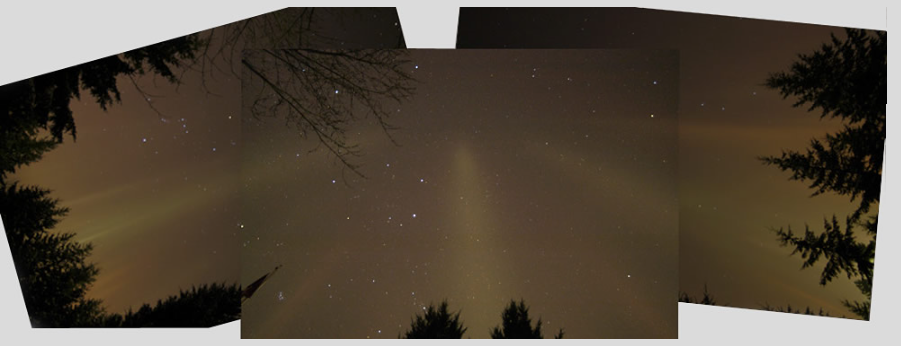Light Pillars to the zenith
Light Pillars to the Zenith: A Spectacular Atmospheric Phenomenon
Have you ever witnessed a mesmerizing display of light pillars reaching all the way up to the zenith? Lauri Kangas, a keen observer, captured these exceptionally tall light pillars in Ontario, Canada back in January 2004. Despite the bitter cold of -24°C, Lauri was determined to document this awe-inspiring spectacle. In this article, we delve into the science behind these captivating light pillars and explore why they appear to converge towards the zenith.
Light pillars are optical phenomena that occur when light from artificial or natural sources is reflected by ice crystals in the atmosphere. Typically, light pillars appear as vertical columns of light extending above or below the light source. However, in rare instances, these columns can reach such great heights that they converge towards the zenith, creating a truly remarkable sight.
The convergence of light pillars towards the zenith is a result of the varying heights at which the plate-shaped ice crystals responsible for the reflections are dispersed throughout the atmosphere. As these ice crystals fall from the sky, they align themselves horizontally due to their shape. When light from streetlights, the moon, or the sun interacts with these horizontally oriented ice crystals, it undergoes a process called refraction. Refraction causes the light to change direction and become vertically aligned, resulting in the formation of the vertical columns we observe as light pillars.
In the case of Lauri Kangas' photographs, the exceptionally tall light pillars reached such heights that they appeared to converge directly overhead at the zenith. This convergence occurred because the plate-shaped ice crystals responsible for reflecting the lights were distributed at different altitudes in the atmosphere. The varying altitudes of these ice crystals caused the light to refract at different angles, creating the illusion of convergence towards the zenith.
It's important to note that light pillars are not limited to a specific location or time of year. They can occur in various regions around the world, particularly in cold climates where ice crystals are more prevalent. Light pillars can be observed during both day and night, depending on the availability of light sources. They are commonly seen in urban areas where artificial lights are abundant, but they can also occur in natural settings with sufficient natural light sources, such as the moon or the sun.
To witness light pillars, it is essential to have the right conditions. First and foremost, there must be a source of light, whether it's streetlights, buildings, or celestial bodies like the moon or the sun. Secondly, the temperature must be cold enough to allow for the formation of ice crystals in the atmosphere. Finally, there should be little to no wind, as strong winds can disperse the ice crystals and disrupt the formation of light pillars.
When you do encounter light pillars, take a moment to appreciate their beauty and understand the science behind them. These captivating optical phenomena serve as a reminder of the wonders that occur naturally in our atmosphere. So keep your eyes to the sky, especially on cold, still nights, and you may just be fortunate enough to witness the extraordinary sight of light pillars converging towards the zenith.

Lights pillars to the zenith. Lauri Kangas (site) saw these exceptionally tall light pillars in Ontario, Canada in January '04. " I managed to get a few images of light pillars that were so tall they converged overhead at the zenith. It was bitterly cold at -24C but there was no wind and there was a drizzle of ice crystals falling from the sky." The light pillars appear to converge towards the zenith because the plate shaped ice crystals producing the reflections of lights on the ground are at different heights in the atmosphere - more here. Images ©2004 Lauri kangas, shown with permission.
Note: this article has been automatically converted from the old site and may not appear as intended. You can find the original article here.
Reference Atmospheric Optics
If you use any of the definitions, information, or data presented on Atmospheric Optics, please copy the link or reference below to properly credit us as the reference source. Thank you!
-
<a href="https://atoptics.co.uk/blog/light-pillars-to-the-zenith/">Light Pillars to the zenith</a>
-
"Light Pillars to the zenith". Atmospheric Optics. Accessed on December 27, 2024. https://atoptics.co.uk/blog/light-pillars-to-the-zenith/.
-
"Light Pillars to the zenith". Atmospheric Optics, https://atoptics.co.uk/blog/light-pillars-to-the-zenith/. Accessed 27 December, 2024
-
Light Pillars to the zenith. Atmospheric Optics. Retrieved from https://atoptics.co.uk/blog/light-pillars-to-the-zenith/.